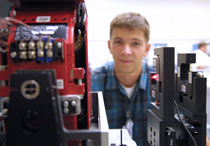
Handy Links
SLAC News Center
SLAC Today
- Subscribe
- Archives: Feb 2006-May 20, 2011
- Archives: May 23, 2011 and later
- Submit Feedback or Story Ideas
- About SLAC Today
SLAC News
Lab News
- Interactions
- Lightsources.org
- ILC NewsLine
- Int'l Science Grid This Week
- Fermilab Today
- Berkeley Lab News
- @brookhaven TODAY
- DOE Pulse
- CERN Courier
- DESY inForm
- US / LHC
SLAC Links
- Emergency
- Safety
- Policy Repository
- Site Entry Form

- Site Maps
- M & O Review
- Computing Status & Calendar
- SLAC Colloquium
- SLACspeak
- SLACspace
- SLAC Logo
- Café Menu
- Flea Market
- Web E-mail
- Marguerite Shuttle
- Discount Commuter Passes
-
Award Reporting Form
- SPIRES
- SciDoc
- Activity Groups
- Library
Stanford
Around the Bay
Michael Levashov: Wired for Science
 Often in science families the electron doesn't fall far from the accelerator—SLAC's Yurii and Michael Levashov are no different. Father Yurii has worked in SLAC's Magnetic Measurement group for three years, and for the last two summers, son Michael has joined the team to work with Linac Coherent Light Source (LCLS) measurement equipment.
Often in science families the electron doesn't fall far from the accelerator—SLAC's Yurii and Michael Levashov are no different. Father Yurii has worked in SLAC's Magnetic Measurement group for three years, and for the last two summers, son Michael has joined the team to work with Linac Coherent Light Source (LCLS) measurement equipment.
A senior at the University of Maryland, Michael says working as a summer student at SLAC has given him hands-on training unlike anything possible at college. He has spent the last three summers at SLAC, with his first summer spent working with what is now the International Linear Collider group. His experiences so far have put his double major in aerospace engineering and physics to good use.
"SLAC's a great place," he says. "It's a physics lab, but much of the day to day work is engineering."
Michael's latest project thoroughly combines his two disciplines of interest: assembling a test stand from components designed at SLAC to help calibrate quadrupole electromagnets. Called a vibrating wire system, Michael has assembled the platform, and will spend the final weeks of his summer commissioning the equipment.
The LCLS will comprise an array of 33 undulator magnets, and between each undulator is a small quadrupole designed to keep the electron beam focused as it passes through the undulator hall. To find the magnetic center, a hair-thin copper wire is threaded through the magnet. The copper wire is energized with a tiny electric current, causing it to vibrate within the magnet's field, while lasers along the 1.5-meter wire detect the vibrations. By moving the stage holding the quadrupole magnet, the central spot along the magnetic axis can be located.
Knowing this parameter to a high degree of precision is essential for the LCLS to operate efficiently. The test stand Michael has assembled is so sensitive that even the slight pull exerted by earth's gravity—causing the wire to sag a few micrometers, even when stretched taught with weights—must be corrected for. The device will enable detection of the magnetic centers to within 25 micrometers—one-quarter the width of a human hair.
Michael's father Yurii, whose high-precision test stand for the LCLS undulators is in the same lab, is stoically confident. When asked how Michael's summers are working out, he says quite precisely, "It's working very well."
—Brad Plummer, SLAC Today, August 15, 2007
Above photo: Michael Levashov. (Click on image for larger version.)